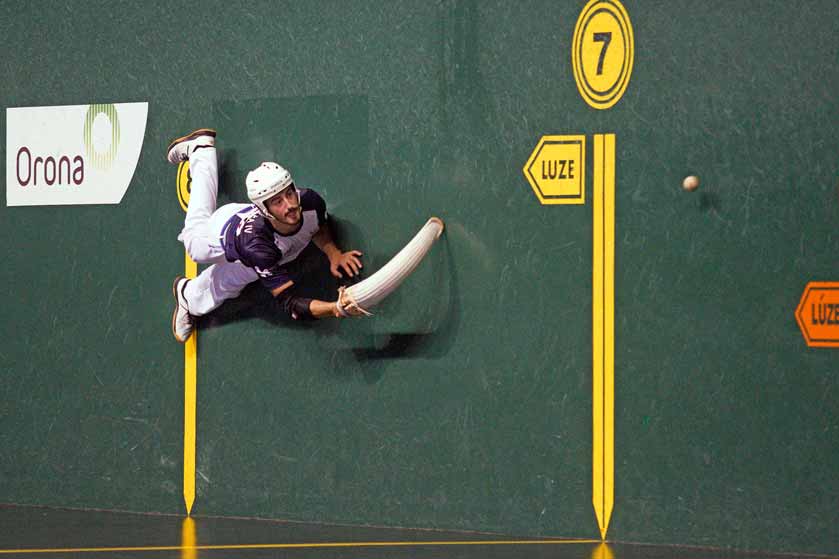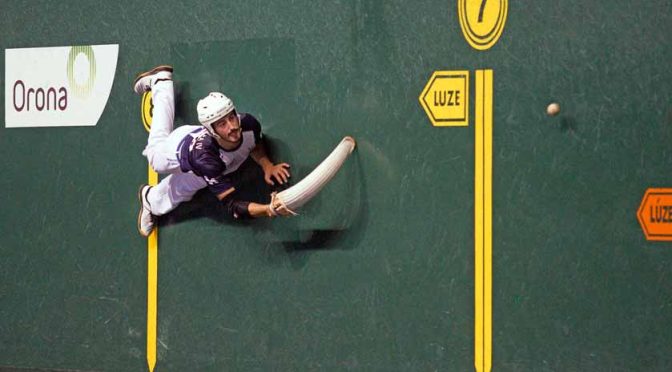While the Basques aren’t the first and only people to play ball games, they have made their own unique imprint on this versatile sport. Pelota a mano, or handball, is the most popular version played today in the Basque Country – when my aunt and uncle ran the Herriko Taberna in Munitibar, it was always on the TV in the bar. On the other hand (no pun intended), Jai alai is probably the most famous version played outside of the Basque Country. However, there are a lot of other variants, using other types of baskets, wooden bats or rackets, and even lacrosse-like nets, that are played across the Basque Country and the world.

- Pelota is typically played in a fronton, usually either with one (primarily in Iparralde) or two walls. However, more formal games are played in one of three types of courts. A trinquet essentially has four walls, though the right wall is made of glass and the left wall has a dugout. The “mur a gauche” is open on the right and is 36 meters (118 feet) long. A jai alai court is the same, but is instead 54 meters (177 feet) long.
- There are multiple “modalities” of pelota. The most popular, at least today, is pelota a mano or handball. However, the most famous outside of the Basque Country is zesta punta, or jai alai. Characterized by its long woven basket – 110 centimeters (43 inches) along the curve – it was first introduced in the 1860s by Gantchiqui Dithurbide from Saint-Pée, Lapurdi. In zesta punta, the ball is caught and thrown with the basket. Sometimes called the fastest sport in the world, José Ramón Areitio once threw the ball at 302 km/h (188 mph), a world record for any ball sport at the time (a record that has been since broken by a golfer). When played in an open court in Iparralde, this game is called Grand Chistera.
- There are other versions of pelota that also use a basket. Joko garbi, or the “clean game,” uses a flatter and shorter basket than jai alai, to help eliminate the ability to catch and hold the ball. Remonte is very similar, though with a slightly larger basket than joko garbi. That is, while the jai alai basket has a well, where the ball can be caught, these baskets do not, preventing the player from holding the ball.
- Pasaka is one of the oldest versions, and is closer to tennis, where the teams face each other, passing the ball over a net. It can be played with bare hands or with a glove that has a short basket attached to it, an earlier version of the baskets used in jai alai, joko garbi, and remonte.
- More common is pala or paleta, in which a wooden bat is used to hit the ball. There are a number of variants of this version of pelota, from paleta goma, first played in Argentina, to pala corta and larga. These variants of pelota differ in the nature of both the bat (how long and wide it is) and the ball (whether it is made of rubber or another material). You can always find kids playing some type of pala in the frontons of the Basque Country.
- Sare uses a type of racket in which the threads are not as tight as, for example, a tennis racket, and so the ball can be caught, similar in spirit to lacrosse (the Basque word sare means net). Of those variants of pelota played at an international level, sare is the least played. This version arose amongst the Basque communities of Argentina and Uruguay before finding its way back to the Basque Country.
Primary sources: Basque pelota from the ground up, Euskal Etxea 74; Basque pelota, Wikipedia; Pelota vasca, Wikipedia; Jai alai, Wikipedia; Letamendia Loinaz, Ander. Pelota vasca. Auñamendi Encyclopedia. Available at: https://aunamendi.eusko-ikaskuntza.eus/en/pelota-vasca/ar-102458/; Bilbao Jai Alai
Discover more from Buber's Basque Page
Subscribe to get the latest posts sent to your email.


